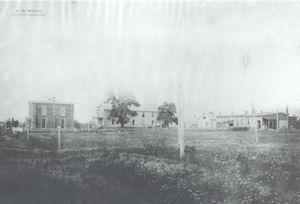Milestones:Thomas Alva Edison Historic Site at Menlo Park, 1876
Thomas Alva Edison Historic Site at Menlo Park, 1876
Between 1876 and 1882 at Menlo Park, New Jersey, Thomas Edison developed the world’s first industrial research and development laboratory devoted to developing new technology. At this laboratory Edison and his staff developed the first system of incandescent electric lighting and electric power generation, and invented recorded sound and a commercially successful telephone transmitter.
The plaque can be viewed at the Menlo Park Museum, 37 Christie St., in Edison, New Jersey, U.S.A.
Menlo Park, New Jersey is where Thomas Alva Edison (1847-1931), America’s greatest inventor, developed technology that changed the world. Nicknamed the “Wizard of Menlo Park”, Edison resided and worked at Menlo Park from 1876 to 1884, turning the site into a center of invention and innovation.
The Menlo Park laboratory was the first center for research in which investigation by a team of individuals with diverse technical backgrounds and experience would be focused on developing practical products. This New Jersey site was chosen by Edison to escape from the hectic New York metropolitan area so that he could focus solely on the invention process. The lab was equipped with the latest state-of–the-art scientific electrical, chemical and mechanical instruments, tools and materials required to perform experiments.
In 1877, Edison successfully developed the carbon button transmitter (or microphone) and the induction coil that greatly improved on the Bell telephone. These Edison innovations enabled the telephone to be used simultaneously as both a sound transmitter and receiver and allowed communication over longer distances with greater clarity and volume.
In the same year, Menlo Park became the “Birthplace of Recorded Sound” with the invention of the phonograph. Edison successfully recorded the movements of a diaphragm generated by sound on a piece of paraffin paper with a needle and then played back the sound by passing the paper back through the diaphragm again. A more complex cylindrical device using tin foil as the recording media followed. This invention, his favorite, was a logical extension of his previous work with the telegraph and the telephone.
On New Year’s Eve 1879, the first use of practical incandescent lights for street lighting was demonstrated at Menlo Park right on Christie Street. This event foreshadowed the end of the gas light era and the beginning of the electric light and power industry. Soon after, Edison began to test his future lighting system with an electric network of feeder, mains and service wires. Wooden lampposts were installed along imaginary streets and half dozen houses were wired along with the laboratory and other buildings. The system was successfully demonstrated in 1881 and led to the award of a franchise to electrify New York City in that year.
Edison also pioneered in railroad electrification. In 1880, a prototype electric railway was constructed at Menlo Park running about one-third of a mile around a hill and back. A small electric locomotive was powered by a dynamo functioning as a motor. Current was supplied from the generating station in back of the laboratory to the rail.
The years at the Menlo Park labs were most productive in Edison’s working life. From 1876 through 1884, over 400 patents for electrical, electro-technology or electro-mechanical devices were generated at Menlo Park. To commemorate Edison, the Thomas Alva Edison Memorial Tower and Menlo Park Museum was built in 1937 and dedicated to him the following year. The Tower is located where Thomas Edison had his laboratory.
The Menlo Park site was totally devoted to the advancement of the application of science and technology for practical products to be used for the benefit of society. The inventions and innovative achievements produced at Menlo Park impacted all aspects of the world. At the site, Thomas Edison carried out technology innovation, business creation and societal improvements which continue on today. In addition, Menlo Park became an important model for the industrial research laboratories of the early 1900s. Every major corporation and university has a research and development laboratory, recorded sound is everywhere, telephone and electric light and power systems blanket the globe. It all began at Menlo Park where “Today was Invented.”
<googlemap controls="small" height="250" width="300" zoom="10" lon="-74.33743" lat="40.56503" version="0.9">
40.56503, -74.33743, Thomas Alva Edison Historic Site at Menlo Park, 1876 Israel Institute of Technology, Haifa, Israel </googlemap>
